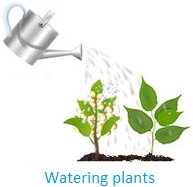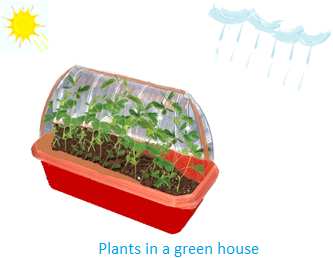Care of Plants
We should take care of plants because plants help us in many ways, like:
(i) Plants provide us food and clean the air.
(ii) Plants give us wood, medicines, cotton and many other things.
(iii) Plants maintain carbon-di-oxide - oxygen balance in air.
(iv) Plants help in bringing rains and preventing floods.
(v) Plants help in maintaining moderate temperature and humidity.
Thus, we should protect the plants in order to keep on enjoying all the benefits.
How should we take care of the plants?
We should take care of the plants by the following ways:
(a) Watering: Water is necessary for germination, rapid growth and healthy life of the plants.
In rainy season, when there is enough water, we see a large number of
plants growing and making the land, green. We should take care to water
the plants regularly at proper intervals.
(b) Protection from
heat and cold: Too much heat and too much cold, both are harmful for
the plants. Too much heat scorches the plants. Too much cold causes
frost and the plant are damaged by it. Therefore plants should be
protected from heat and cold.
Young plants should be protected against heat by erecting grass-roof over the plant-bed. In cold season, the plants may be protected against cold by keeping them in a green house.
(c) Sunlight: The process of photosynthesis, which produces food for plants, is performed only in presence of sunlight. In absence of sunlight, the plants cannot grow properly and turn pale. Thus the should get sufficient amount of sunlight.
(d) Manure: For proper growth, plants need sufficient quantity or fertilizers or manure of the right type. We should provide them with these.
(e) Protection against insects and diseases: Some insects damage a plant, its roots, leaves, flowers and fruit. Agricultural scientists recognize the insects or pests and advise to spray the affected parts over with certain insecticides to kill them.
Sometimes plants suffer from diseases. Their flowers, vegetables and fruits are attacked by some disease. In such a situation we should consult an agricultural scientist and according to his recommendation, the plants should be sprayed with dilute solution of a suitable insecticide.
We should follow its recommendations and do the needful to protect the plants.
How to grow more plants and protect trees?
Sometimes save forests programmes is also launched to protect forests and trees. Such programmes are aimed to fulfill the needs of the growing population regarding food and shelter.
Forests are not only a great source of food and shelter for animals but we also get wood from them. Forests are helpful in bringing rains. They also prevent floods and soil erosion.
We should co-operate with the government to grow more trees and to protect the forests. We should avoid cutting down trees specially in the forests. We should also protect forests from fire.
From Care of Plants to HOME PAGE
Recent Articles
-
What Is Plasma? | Blood Plasma | Proteins | Nutrients | Cholesterol
Nov 07, 25 10:29 AM
Blood is a mobile fluid which is a connective tissue and is derived from the mesoderm like cell any other connective tissue. Colour of blood is reddish and that flows inside the blood vessels by means… -
Disorders of Respiratory System | Tuberculosis | Pleurisy | Emphysema
Oct 28, 25 11:39 PM
Tuberculosis is very common disease and is caused by a type of bacteria called Mycobacterium tuberculosis. This disease causes different trouble in the respiration and infection of several parts of th… -
Regulation of Respiration | Respiratory Centres | Inspiratory Area |
Oct 14, 25 12:13 AM
Respiratory Centre is the area that controls the rate of respiration and it is observed to be located in medulla oblongata and pons. Respiratory Centre has the following will dispersed components like… -
Explain Transport of Gases | External Respiration | Tissue Respiration
Oct 09, 25 11:35 PM
In humans gaseous exchange is completed in the following ways the steps are - External Respiration or Breathing - Breathing in false taking in of Oxygen and giving out of carbon dioxide in the body. M… -
Kind and Number of Teeth | Location of Teeth in Mouth | Care of Teeth
Sep 11, 25 12:52 AM
Kind and Number of Teeth







New! Comments
Have your say about what you just read! Leave me a comment in the box below.